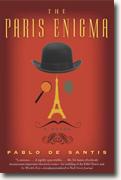The Paris Enigma
Pablo de Santis
book reviews:
· general fiction
· chick lit/romance
· sci-fi/fantasy
· graphic novels
· nonfiction
· audio books
· author interviews
· children's books @
curledupkids.com
· DVD reviews @
curledupdvd.com
newsletter
win books
buy online
links
home
for authors
& publishers
for reviewers

 |
The Paris Enigma Pablo de Santis HarperPerennial Paperback 256 pages December 2009 |
|
A fun, suspenseful whodunit, The Paris Enigma
Unfortunately, Renato Craig’s days as a leading gumshoe are coming to a close. Shortly after his favorite student goes missing, Craig sets out on a journey that ends his career and leaves him a hopeless invalid. So when the co-founder of The Twelve Detectives - an improbable group of the world’s most illustrious investigators - summons Craig to Paris to mount an exhibit for the World’s Fair, he sends Salvatrio in his place. Upon his arrival in Paris, Salvatrio soon finds himself embroiled in a complex mystery that begins with the death of Louis Darbon, one of the more irascible members of The Twelve. Darbon - the rival of Polish detective Viktor Arzaky - had been investigating several of the esoteric groups opposed to Eiffel’s new tower. When Darbon’s body turns up at the tower’s base the morning after the detectives’ first meeting, the game is afoot. As Salvatrio searches for the larger picture, each of the eleven remaining detectives scrambles to solve the mystery first in an effort to display his superior ability before the world. When the charred corpse of a decapitated criminal turns up at one of the Fair’s exhibits, the mystery deepens. In his quest for truth and, perhaps, glory, Salvatrio meets a beautiful actress whose nightly dives into an icy pool of water have hypnotized the men of Paris, an alchemist who believes the Eiffel Tower is one of three points on the Hermetic triangle, and a detective’s assistant whose secret could mean the demise of The Twelve. In the end, the answer to the “Paris Enigma” is as simple as the answer to every riddle is – in retrospect, that is. Winner of the Premio Planeta award for Best Latin American Novel, The Paris Enigma De Santis’ approach works in part because of the somewhat contained length of the novel, the appeal of the historical setting, and the deceptive complexity of the plot. In a longer mystery the slightly ironic casting, which consists of a circus mix of mostly two-dimensional characters – including America’s pistol-waving Jack Novarius and his Tonto-esque Indian sidekick – might become tiresome. For readers who want an engaging novel that will hold their interest without making too many emotional or intellectual demands, The Paris Enigma Originally published on Curled Up With A Good Book at www.curledup.com. © Lori Lamothe, 2008 |
| Also by Pablo de Santis: |
|
|
|
 Click here to learn more about this month's sponsor! |
|
| fiction · sf/f · comic books · nonfiction · audio newsletter · free book contest · buy books online review index · links · · authors & publishers reviewers |
|
| site by ELBO Computing Resources, Inc. | |
 The novel opens not in Paris but Argentina, where young Sigmundo Salvatrio has been living the steady, insipid life of the son of a cobbler. Salvatrio’s one extravagance is the complicated jigsaw puzzles his father buys him, and it is this passion for creating a sense of out apparent nonsense that leads Salvatrio to answer an ad for detective-school students placed by world-famous investigator Renato Craig. Though Craig tells him that “an investigation and a jigsaw puzzle have nothing in common,” the young recruit’s ability to persevere until the final piece in is place leads him to become Craig’s assistant and, eventually, a full-fledged detective.
The novel opens not in Paris but Argentina, where young Sigmundo Salvatrio has been living the steady, insipid life of the son of a cobbler. Salvatrio’s one extravagance is the complicated jigsaw puzzles his father buys him, and it is this passion for creating a sense of out apparent nonsense that leads Salvatrio to answer an ad for detective-school students placed by world-famous investigator Renato Craig. Though Craig tells him that “an investigation and a jigsaw puzzle have nothing in common,” the young recruit’s ability to persevere until the final piece in is place leads him to become Craig’s assistant and, eventually, a full-fledged detective.